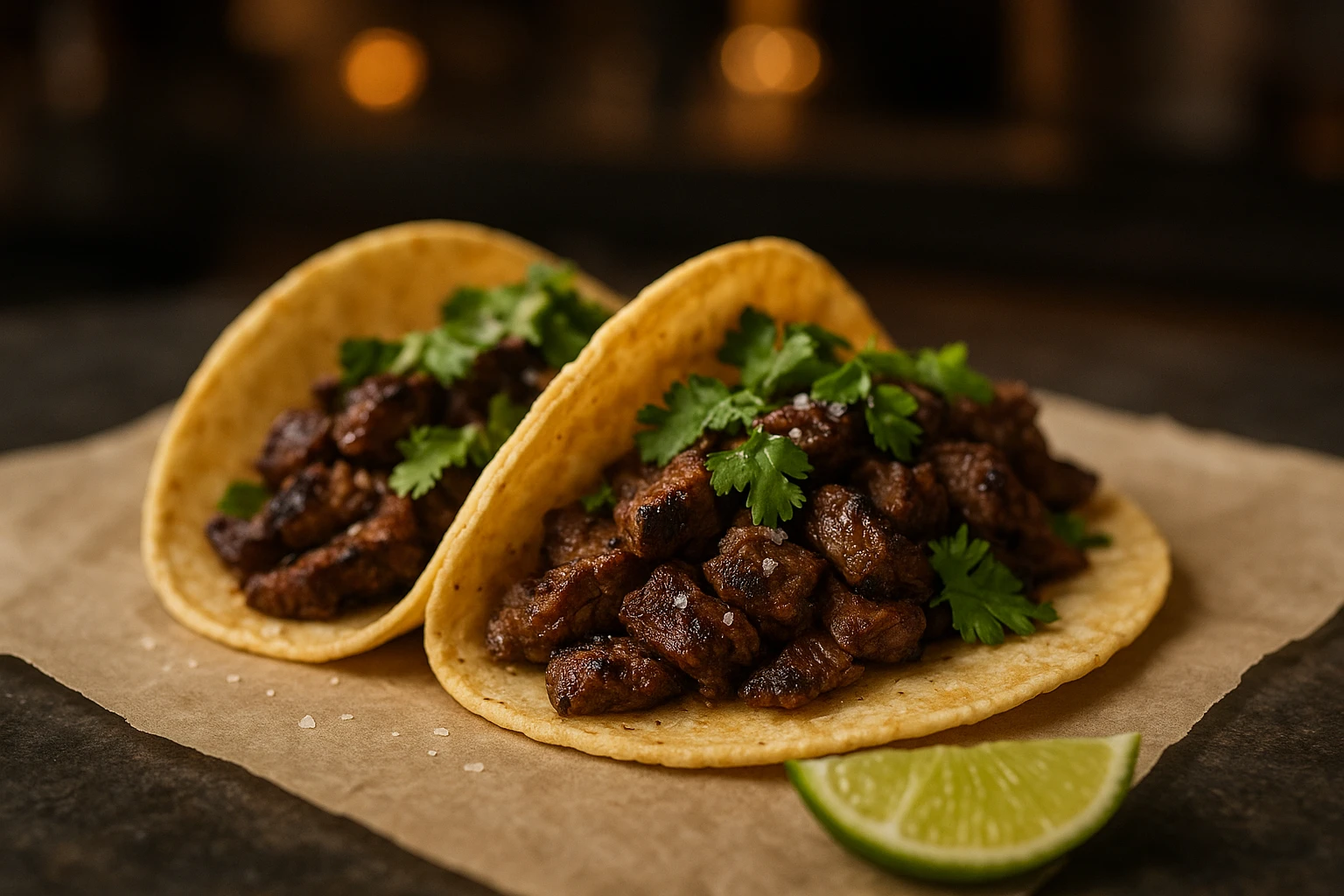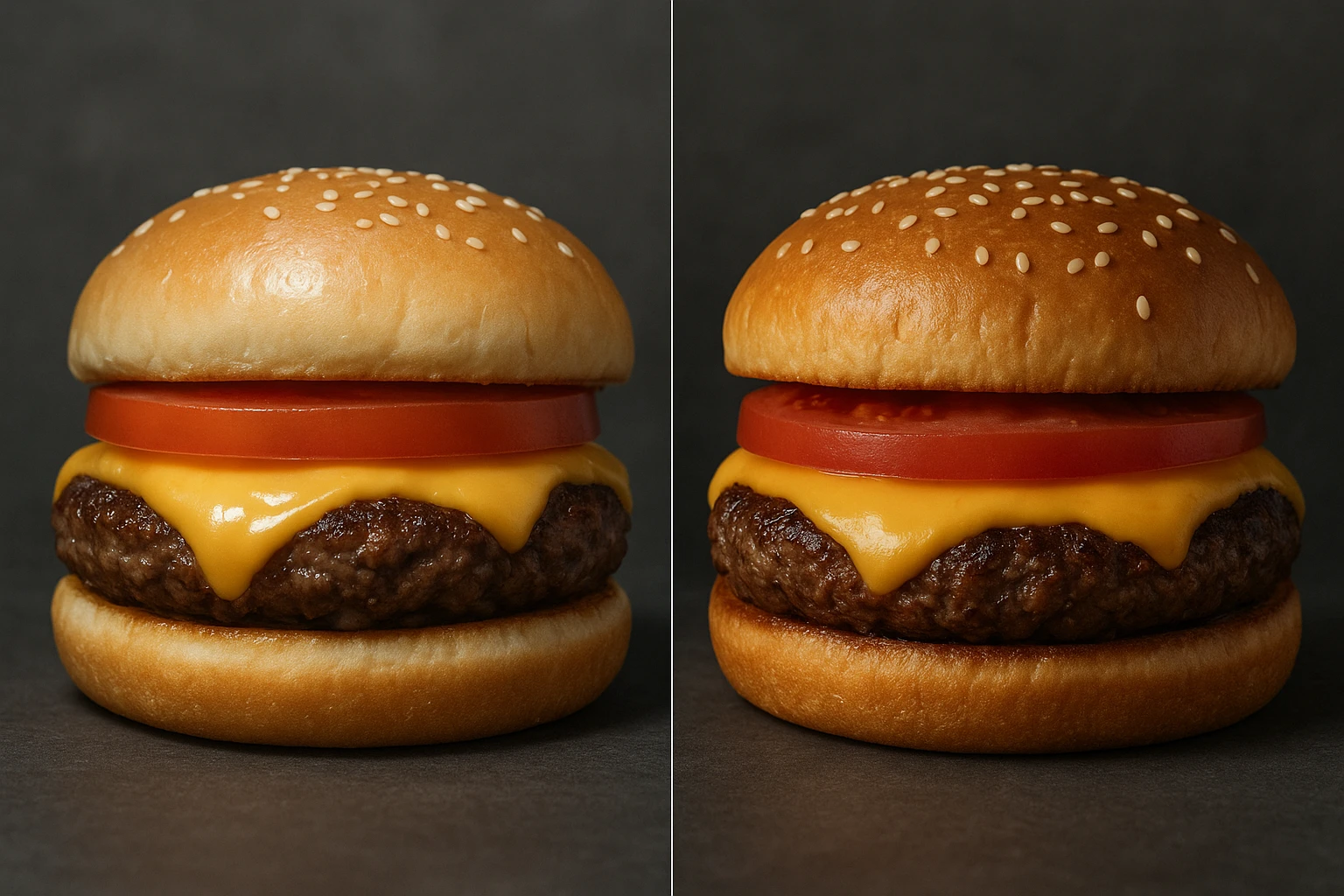Great Photos in Bad Light: AI Fixes for Night Service

Why low light wrecks menu photos (and what it costs you)
Picture a Friday rush. Your line cook snaps the new chili-lime wings at the pass: overhead heat lamps, a 40W bulb over the expo, and neon leaking from the bar. The result is classic night-service chaos: mushy grain, orange skin tones, greenish plates, and shadows that swallow the garnish.
Here’s why it happens:
- Noise from high ISO: In dim light, phones push ISO to 1600-5000. That adds colored speckles and smears fine texture-the crisp you worked for looks soggy on screen.
- Off white balance: Tungsten bulbs (~2700K) plus neon cast greens/yellows. Auto settings chase the wrong neutral, so your aioli turns mustard-yellow and rice looks gray.
- Crushed shadows: Limited dynamic range hides ingredients-char lines on chicken disappear; sesame seeds blend into the bun.
This isn’t cosmetic. It’s conversion and timing:
- A 20-item reshoot with a photographer costs $3,000-$6,000 and takes 2-4 weeks. Seasonal items miss their window.
- Hypothetical but realistic: a burger brand testing brighter, color-true photos on a delivery app could see +5-15% order rate because thumbnails read faster and toppings are recognizable. The mechanism: less visual ambiguity = fewer skipped taps.
If you can turn a dim, noisy snap into a clean, on-brand image the same day, you avoid the reshoot tax, keep menus current, and give customers enough visual detail to choose confidently in 2-3 seconds.
Summary: Low light drives ISO up, skews color, and crushes shadows-hurting clarity and sales. Fixing these fast avoids reshoots and keeps menus current.

What teams try now-and why it often disappoints
When the photo looks bad, most teams try one of four things:
- Crank ISO or use HDR on the phone
- Example: A ramen shop shoots at ISO 4000 in a dim booth. The soup surface gets grainy, and noodles blur at the edges.
- HDR often over-flattens highlights, killing appetizing specularity on glazed pork. You get a flat, chalky tonkotsu.
- Mobile smoothing and clarity sliders
- A burger joint uses a popular app to “reduce noise.” It smears grill marks and sesame seeds into plastic-looking surfaces.
- Over-clarity to “bring back detail” halos the bun edge and exaggerates crumbs, making it look stale.
- Cheap ring light or flash
- Ring light 1 foot away creates a hard, circular catchlight in sauces and glassy glare on fries. Fat looks sweaty, not juicy.
- Phone flash from the front nukes shadows and flattens bun texture. The tomato turns neon.
- Manual desktop edits at 11 p.m.
- Even a skilled marketer spends 20-30 minutes per image in Lightroom fiddling with Temp/Tint, HSL, and curves. For a 12-item update, that’s 4-6 hours you don’t have.
Why it fails:
- Traditional noise reduction treats grain like blur, so you lose micro-edges (crumb, crust, seeds).
- Global white-balance guesses miss mixed lighting (tungsten + neon), so whites still skew.
- Pushing shadows up adds gray haze because sensor noise amplifies with the lift.
Result: time sink, off-brand color, and food that looks worse than it tastes.
Summary: Common fixes-high ISO, HDR, smoothing apps, cheap lights, and late-night editing-either eat texture, skew color, or waste hours.

How AI fixes noise, color, and shadows in Yummify
Yummify’s pipeline is built to repair low-light food photos without plastic skin or weird color.
AI noise reduction that keeps texture
- The model learns the difference between noise and edible detail from millions of samples. It removes chroma speckle while preserving edges like sesame, char, and breadcrumbs.
- Practical example: iPhone shot of carne asada at ISO 3200. After denoising, salt crystals and grill marks stay crisp instead of smearing.
Neural white-balance correction for mixed light
- Instead of guessing a single color temperature, the system identifies true neutrals (plates, parchment, rice) and corrects across regions. It handles tungsten + window spill + neon simultaneously.
- Example: Bar nachos under amber bulbs with green neon. AI neutralizes the green cast on sour cream while keeping the warm chips appetizing, not orange.
Shadow recovery without gray haze
- Learned tone mapping lifts shadows selectively and suppresses amplified noise. Local contrast is reintroduced so folds in tortillas and crumb structure come back.
- Example: Chocolate cake slice where the back half is nearly black. AI lift reveals sponge texture and ganache sheen without muddy gray.
Workflow in Yummify (8-12 minutes typical)
- Upload a reference photo (the AI validates it’s food).
- Select or create a branded environment (e.g., “Warm Rustic, terracotta, soft side light”) for consistent style across items.
- Generate a styled image; review 2-4 variants.
- Use Quality Upgrades only on keepers (e.g., hero menu tile).
- Optional: start from a text prompt if your reference is unusable; Prompt Enhancement fills in missing detail.
Outcome: a consistent, natural look that reads clearly in 2-3 second delivery-app scans, without the plastic, overprocessed feel.
Summary: Yummify uses learned denoising, neural white-balance, and selective shadow recovery to fix dim shots while preserving appetizing texture and consistent brand style.
Three realistic night-service scenarios (before/after)
Scenario A: Taco truck at 9:30 p.m.
- Input: iPhone 12 shot, ISO ~3200, tungsten bulb at the pass. Noise in tortillas, lime looks brown.
- Yummify pass: denoise preserves char, WB correction restores lime to green, shadow lift reveals cilantro. Time: 18 minutes from upload to approved tile. Hypothetical but realistic impact: a 10-dish update done in under an hour instead of a $1,500 weekend shoot.
Scenario B: Sushi bar with neon spill
- Input: Magenta neon hits a salmon nigiri set; rice goes purple, nori gloss disappears.
- Yummify pass: AI identifies rice as neutral, corrects tint without killing warm wood tones in the board. Shadow recovery brings back the nori sheen. Turnaround: 12 minutes. The team tests two branded environments (cool minimal vs warm izakaya) for A/B in the delivery app.
Scenario C: Ghost kitchen pizza slice in a dim prep hallway
- Input: Overhead 2700K bulb; shadows crush pepperoni edges; cheese looks dull.
- Yummify pass: Denoise + local contrast returns the cheese’s oil highlights, WB normalizes reds, and shadows reveal crust bubbles. They process 8 SKUs in ~40 minutes at standard quality, then upgrade the top 3 for the menu hero and aggregator hero images.
Common thread: You can iterate in minutes, maintain one look across the set with branded environments, and only pay the Quality Upgrade tax on the winners-avoiding 2-4 weeks of scheduling and 4-figure invoices.
Summary: Three night-service examples show fast fixes: tacos under tungsten, sushi under neon, and pizza in a dim hallway-each corrected in minutes with consistent style.
Pre-service capture checklist for usable inputs
These tips make your inputs “AI friendly” so fixes work better.
Phone settings (60 seconds)
- Clean the lens (shirt hem is fine in a pinch).
- Lock focus/exposure on the food; then slide exposure down slightly (about ?0.3 to ?0.7 EV). Darker inputs recover better than blown highlights.
- Avoid digital zoom; step closer to keep native detail.
Quick lighting tweaks (2 minutes)
- Move the plate near the pass window or a wall to bounce light. A white takeout box at 6-12 inches makes a good reflector.
- Kill mixed color if possible: turn off the nearest colored neon for 15 seconds while you shoot.
Color reference (30 seconds)
- Put a folded white napkin or a scrap of parchment in the frame edge for one shot. Yummify’s WB correction uses it as a neutral guide; crop it out later.
Angles that survive noise reduction
- Three-quarter angle or a low overhead (5-15?) keeps depth and avoids flatness. Side light from 45? gives texture the AI can protect.
- Avoid shooting directly under the bulb; shift 1-2 feet to the side to prevent harsh top-down shadows.
Fast upload workflow in Yummify
- Shoot 2-3 frames per dish.
- Upload the best to Yummify.
- Apply your branded environment for consistent style.
- Approve one standard-quality result; only upgrade the few that will live on menus and delivery apps.
Common mistakes to avoid
- Overexposing shiny sauces (hard to pull back).
- Heavy ring lights within 1 foot (creates glare that AI will preserve).
- Shooting next to green tiles without a neutral reference.
Summary: Simple in-service habits-slight underexposure, bounce light, neutral reference, and consistent angles-give AI the signal it needs for better fixes in minutes.

Next steps
Try this workflow on one dish tonight: shoot two quick frames near the pass, underexpose slightly, and upload to Yummify. Apply your branded environment and compare the AI-fixed result to your raw phone shot at thumbnail size-the difference is obvious in 2 seconds. Keep standard quality for testing, then upgrade only your top performers for menus and delivery apps. You’ll replace a $1,500 weekend shoot with a 30-minute desk session and have fresh, consistent images ready before tomorrow’s lunch rush.
FAQ
Can I use my own photos, or do I have to start from text prompts?
You can do either. Most users upload a quick phone shot because it ensures the dish looks like your actual food-then Yummify fixes noise, color, and shadows while applying your brand style. If your reference is unusable (e.g., motion blur), start from a text prompt and describe the dish; Prompt Enhancement fills in missing detail. Many teams mix both: photo for core menu items, prompt-only for specials they haven’t plated yet.
How does this compare to hiring a photographer for low-light situations?
A photographer brings lighting and control that no app can fully replicate-ideal for hero campaigns. For menu updates and delivery thumbnails, Yummify gets you from dim snap to consistent, on-brand images in minutes at a fraction of the cost. You also gain fast iteration: generate multiple styles, then choose what reads best in small thumbnails. Many restaurants use Yummify weekly and hire a photographer quarterly for big hero shots.
Do I need special equipment to shoot in dim kitchens?
No special gear is required. A recent smartphone works, especially if you slightly underexpose and avoid digital zoom. If you have $20-$30, a small foldable reflector or a pocket LED at 10-20% bounced off a wall can help, but it’s optional. The key is stable framing, a neutral reference (napkin or parchment), and consistent angles that AI can enhance without artifacts.
What if my lighting mixes neon, tungsten, and daylight-can AI handle that?
Yes. Neural white-balance correction looks for true neutrals and adjusts regions independently, so neon spill on one side and warm bulbs on the other can be corrected without turning everything gray. A quick neutral reference in the frame (a white napkin) makes it even more reliable. When possible, briefly switch off a colored neon near the pass to reduce conflict.
Will noise reduction make my food look plastic or over-smoothed?
That’s a risk with generic smoothing apps. Yummify’s denoising is trained on food textures, so it suppresses chroma noise while protecting micro-detail like crumb, char, and seeds. If you start with a slightly darker but sharp photo, the AI retains edges better than if you overexpose and clip highlights. Review at thumbnail and full size; upgrade quality only on the best frames.
How long does it take to learn and get consistent results?
Most teams are comfortable within one service. The workflow is simple: shoot, upload, choose a branded environment, and review 2-4 variants. Create your branded environment once, then reuse it for every dish so color and lighting stay consistent across locations. Expect a 10-15 minute per-item cadence initially, dropping to 6-10 minutes once your environment and angles are dialed in.


